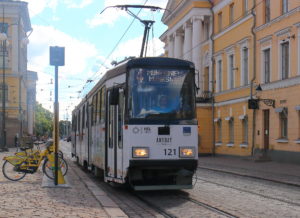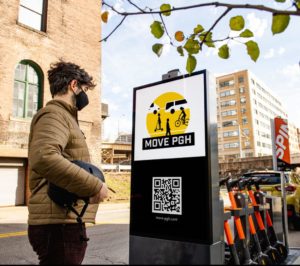
Photo: BVG Jelbi Station Friedrichstraße
MaaS faces its make-or-break moment
08 September 2021
by Christopher Carey
Can MaaS live up to its promise or is it time to move on? Christopher Carey analyses the journey so far and looks to what’s next.
For the past six years, Mobility-as-a-Service (MaaS) has both intrigued and frustrated those working in the transportation field.
Its promise of creating a seamless interface where all transport modes – from buses to bike-shares – can be accessed through one app has been on the horizon for a while now.
But this dream of a world where car ownership is no longer the most attractive option for getting around still seems distant, despite millions of dollars of investment and countless hours spent discussing its future potential.
Competing interests between public and private transport operators have led to a stalemate but new momentum from cities in the US, Asia and Europe could signal real progress ahead for both sides, if the persistent roadblocks can be overcome.
Defining the common goal could be a start. For many, the subjective and interpretative nature of this all-encompassing acronym (much like the ‘smart city’) has often served to confuse rather than clarify.
“I think a lot of the definitions [of MaaS] are self-serving, because they’re from companies that want to sell a product, so they come up with their own definition,” said David Zipper, Visiting Fellow at the Harvard Kennedy School’s Taubman Center for State and Local Government.

“For me, MaaS is a platform that [provides] multiple ways of travelling around a city and makes it easy to plan journeys and purchase tickets or a bucket of mobility products through a subscription, which should hopefully make it easier for people to feel like they have freedom to travel comfortably everywhere without having to drive a car.”
But with only a handful of established MaaS programmes rolled out to date – Helsinki, Antwerp and Berlin being the most notable examples – cities are finding the concept is much simpler in theory than in practice.
A brief history
The term was first coined in 2014 by Finnish engineering student Sonja Heikkila, while writing her master’s thesis at Aalto University.
Though the foundations of the idea had existed since the late 1990s, it was Heikkila’s vision of an all-encompassing digital service which would merge the mobility ecosystem that is widely regarded as the birth of modern MaaS.
Sampo Hietanen, Heikkila’s thesis supervisor, subsequently went on to form MaaS Global in 2015 – the firm behind Helsinki’s pioneering Whim app.
The first practical example of MaaS in cities, Whim allows Helsinki residents to choose between multiple tiers of service, including a pay-as-you-go option and a €62 (US$73) monthly subscription that provides unlimited public transport and short taxi rides, as well as one shared bike trip and discounted car rental.
Whim’s evolution was facilitated by a 2017 law passed by the Finnish government that required all transport providers — both private companies and public transit authorities — to share data with one another and enable other parties to sell their trips.
The legislation was groundbreaking in that it essentially created an environment for MaaS to thrive, but would also lead to the ongoing conflict between the company and the city-run Helsinki Regional Transport Authority (HSL).

With its own mobile ticketing app, HSL had little incentive to open the market to MaaS providers, and was soon accused by MaaS Global of refusing to share easy access to its popular monthly transit passes.
The firm subsequently appealed to the Finnish Competition and Consumer Authority in the hopes of collecting service fees over and above the face value of a transit ticket, with the case still ongoing.
“One of the hardest parts of this industry is knowing how to bring everyone to the same table,” said Sampo Hietanen, CEO, MaaS Global.
“And with MaaS, first you need to get everyone saying ‘OK, we’re going to commit to being in others’ platforms jointly with our competitors’.
“So it’s hard for someone to invest in something like this if you don’t have any kind of certainty.”
Financial problems
But MaaS providers’ woes go deeper than cooperation issues.
The pandemic has had a dramatic impact on the transport sector overall, but private sector operators who lack the insurance of a government bailout when the going gets tough have been hit particularly hard.
Finnish MaaS firm Kyyti and Singapore’s Zipster recently collapsed, and Citymapper has turned to crowdsourcing to raise fresh funds.
Razor-thin profit margins, where companies only earn a small commission when a commuter uses a specific service, means a high volume of trips are needed to sustain profitability.
In June, Finnish newspaper Helsingin Sanomat reported that MaaS Global had spent €50 million on “failed expansion ventures”, something the company disputes, saying the money was spent on “integrating multiple transportation providers, establishing market readiness in several countries, and developing the complex technology that underpins the app”.
“Whether the €50 million has been spent wisely remains to be seen, as is always [the case] with any kind of risk venture,” Hietanen maintained.
“But with 16 million lines of code and some 20 million trips completed – some might say it’s been pretty well spent.”
The firm recently secured €11 million in funding from Spanish firm Ferrovial and the Finnish state private equity company Tesi, and says it will be announcing an expansion into new markets soon.
Put up or shut up
According to HSL, Finland’s MaaS platforms have never accounted for more than two percent of regional transit ticket sales, and in the first half of 2021 that figure was one percent.
Similarly low or non-existent figures from other MaaS projects mean cities and industry analysts are often in the dark about how many people actually use these services.
“I think it’s time for put up or shut up – MaaS providers need to actually show that they can attract a lot of people to their platforms and change modal choice because it hasn’t happened yet,” Zipper added.
“There have been many years of hype, perhaps excessive hype, and it’s time to show that MaaS is actually changing behaviour. Otherwise, it is just one big distraction.”
The question over whether private firms will simply prioritise transport options that pay them higher commissions, like ride-hailing services, over public transport options also looms over cities.
Hietanen admits that while this is a possibility, it wouldn’t be in the interest of MaaS firms in the long term.
“There is a fear of these commissions, and yes, they do exist if we are forced – like in Vienna – to only sell these single tickets [instead of packaged options].
“But I think MaaS is often misunderstood in that people think us reselling single tickets or rides for commissions is the best way of doing business.
“That’s by far not the best driver for sustainability or profits.”

Referring to the firm’s subscription packages, Hietanen says its more lucrative for MaaS firms to push lower-cost options like public transit and micromobility services.
But this subscription-based concept of MaaS, where users give up their vehicle for an all-inclusive package would require a much wider mindset shift, something which is most immediately challenged by how car owners consistently miscalculate the cost of owning and running a car.
A German study published in academic journal Nature last year found that motorists can underestimate the total cost of owning a car by as much as 50 percent.
It also found that educating people about the true cost could reduce car ownership in Germany by up to 37 percent – something which will be music to MaaS proponents’ ears.
Trial and error
Outside of Finland, MaaS services have popped up, but their success has been limited.
In March 2018, Transport for West Midlands (TfWM) joined forces with MaaS Global to develop the UK’s first MaaS service.
The trial venture was based on a subscription model that offered users an all-inclusive monthly package, with prices ranging from £99-£349 (US$136-US$480) for unlimited access to the region’s buses, trams, taxis and bike -share schemes.
But for Chris Lane, TfWM’s’ Head of Transport Innovation, the end result did not meet expectations.
“We found from that trial that we really weren’t reaching the size and number of people that we wanted to, because it was purely commercial, and it really does depend on the size of the marketing budget.
“So if you’re the Ubers of this world, you’ve probably got quite a large marketing budget to reach a lot of people, but we weren’t able to do that with that original service.”
“We don’t have overall figures [for how many people used the Whim service] because it was purely commercial – MaaS Global has those [the figures].”

Hietanen did not comment on Whim’s exact user numbers for the project, but said they were “not humongous”.
“But we thought the figures were low, not because people didn’t like the service, but because the service really wasn’t as extensive as it could be,” Lane added.
TfWM recently launched a tender looking for partners for a new mobility-as-a-service (MaaS) application project, which it says will “provide a step-change improvement in the customer experience for planning, booking and paying for travel using sustainable modes of transport in the West Midlands”.
Lane says the lessons learned from the previous scheme have shown that a transport authority-led approach to MaaS was the right fit for the region.
“The big difference between this mobility-as-a-service solution and what we’ve done previously, is that we’re building this on top of our successful Swift smartcard ticketing system.”
Berlin
Perhaps the most extensive example of MaaS today can be found in Germany’s capital, Berlin.
The city’s Jelbi app integrates even more mobility options than Helsinki’s Whim, including ride-hailing services, and while the package uses a private sector firm – Trafi – to operate the app, it is the public transit operator BVG that calls the shots.
“I think that a few years ago there was a realisation that mobility trends and demands were shifting and that the offers of services in the city were also shifting as more shared operators were joining the space,” said Sebastian Wolf, Jelbi Project Lead, BVG.
“We saw an opportunity to interpret the role of providing mobility for the city and create a cost-effective, viable alternative for those who wanted to give up their car.”

When asked about the potential for a conflict of interest – where the public transit operator would favour public transit options over those shared services offered by the private sector, Wolf said he didn’t see an issue.
“Our competitor is the privately owned car, not other private forms of mobility,” he commented.
But this competitor is a significant player in Germany.
Levers to discourage car use in Berlin are not as strong as other European cities, with parking rates still relatively cheap in many parts.
For Jelbi to truly succeed, the city will have to up the pressure on cars, something which would require a much wider engagement with other municipal departments and be a difficult sell politically for a nation of automobile enthusiasts.
“We want to enable more people to live in a growing city without owning a car, so offering diverse mobility alternatives makes it easier to switch,” added Michael Bartnik, Project Manager, BVG.
But as it stands, the number of Berliner’s actually using this MaaS offering is not known – BVG would not comment on the figures, saying it doesn’t publish the number of bookings and tickets made through the Jelbi app.
This lack of transparency means that while the app may tick all the boxes from a technological standpoint, its true effectiveness is known only by those closest to it.

Besides offering a digital mobility service, Berlin has also rolled out mobility hubs that bring different shared modes of transport together in one place.
The city now has 12 Jelbi stations which host a wide variety of services – from car and bike sharing to on-demand shuttles, and 24 Jelbi points dedicated to micromobility options like bikes and e-scooters.
This integration of physical locations where the user can effectively see MaaS in action, is something that has gathered pace across Europe in recent years, and also found its way to the US.
Pittsburgh
In July, Pittsburgh’s Department of Mobility and Infrastructure (DOMI) launched Move PGH – an ambitious plan to reduce reliance on cars by boosting multi-modal options.
The initiative centres around 50 new physical mobility hubs across the city, and a digital service powered by Transit.
“We’re really excited about this,” said Karina Ricks, Director of Pittsburgh’s Department of Mobility and Infrastructure.
“There’s a three-fold problem that we’re trying to solve. One is that with all the independent [mobility] services provided in an area, it can be very hard for the user to figure out how to cobble these together.
“The second problem is related to climate change – we really need urgent action to make it easier for people to reduce their driving.
“The last thing is related to the mobility gaps in our system. We’re talking about mobility insecurity – we’ve heard of people being food insecure, but they can also be transportation insecure.

The city says Move PGH is the country’s first integrated MaaS project that connects traditional and emerging low-cost, shared transportation options into a single, easy-to-use system.
The scheme also focuses on the hot button topic of equity, with the city launching a Universal Basic Mobility programme that provides up to 100 low-income residents with monthly transit subscriptions and shared mobility services for six months.
The initiatives are the result of more than two years of work by a public-private-nonprofit partnership led by DOMI and built around existing public transit and bike share schemes.
“I think it’s quite clever what they’ve [DOMI] done,” added Zipper.
“They have leveraged the power of permits for scooters – because they only gave one to a company called Spin – to sort of compel them and lots of other companies that have been brought together to be part of the integrated city-run platform.”
City-led future?
When looking at the bigger picture, MaaS is still a concept in its infancy.
The pandemic may well prove to have been a turning point in that it has exposed the shortcomings of a private-sector-led model, but it has also shown cities how important firms providing shared services are to the transport ecosystem.
There is a growing belief among cities that they can be the ones to set the rules for MaaS, and this confidence could see the emergence of a MaaS 2.0 model, that also incorporates social factors like equity into the mix.







